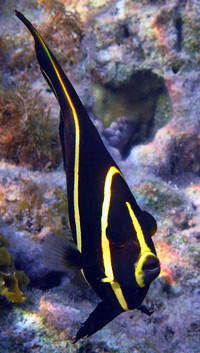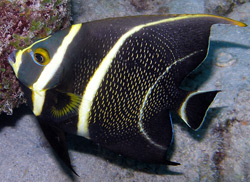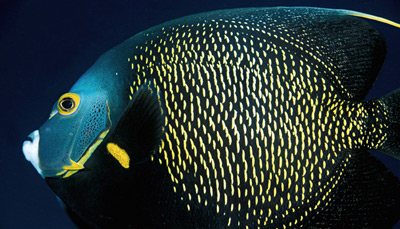One of my more enduring memories of diving in the Florida Keys was coming across a pair of French angelfish (Pomacanthus paru) gliding in unison above the reef. Unlike so many other fishes that dashed into hiding as I approached, the angels actually swam right into touching distance and seemed to take an interest in my presence. Whether they were naturally curious, accustomed to being handfed, or just amused by the sight of such a big fellow squeezed into a wetsuit, I can’t say, but their beauty and boldness certainly impressed me.
If you happen to have a system large enough to accommodate one of these angels, I don’t think you’ll be disappointed either. Let’s look at their characteristics:
Physical traits

French angels aren’t as spectacularly colored as some reef fishes are, yet they’re subtly beautiful nonetheless. Adults are bluish-black overall with golden-yellow scale margins. The face is slate blue, the mouth is white, and the eyes are rimmed with gold. As with many angelfish species, juvenile French angels differ considerably from the adults in coloration, being black overall with five vertical, curving yellow bars on their flanks. Specimens offered for sale are often somewhere in transition between their juvenile and adult coloration.
This denizen of the tropical Atlantic and Caribbean is laterally compressed (flattened from side to side) and can attain a length of around 15 inches. Elongated filaments develop from the trailing edges of the dorsal and anal fins. Typical of angels, this species also has sharp spines protruding from the opercula (gill covers).
Feeding
P. paru is an omnivorous species that, according to Fishbase.org, feeds on “sponges, algae, bryozoans, zoantharians, gorgonians, and tunicates.” That should tell you that the menu of aquarium specimens needs to include lots of algae-based foods as well as meaty items. To get sponge into their diet in captivity, special angelfish formulations containing sponge should also be offered. Angels tend to nibble and graze throughout the day, so multiple daily feedings are recommended. A note of interest: juvenile French angels are facultative cleaners of other fish species in the wild.

Housing
P. paru demands lots of open swimming space, exceptional water quality, as well as ample live rock to graze upon/hide among, so a tank of at least 250 gallons is recommended for keeping one happy and healthy. Of course a tank bigger than the minimum is always better for the long term.
Compatibility

I would describe P. paru as moderately aggressive, so that calls for tankmates assertive enough to hold their own, such as surgeonfishes, rabbitfishes, wrasses, more sociable triggers, etc. Generally speaking, conspecifics and very similar-looking species are best avoided.
Owing to its propensity to nip or outright consume a wide variety of sessile invertebrates, this species is not a good candidate for reef aquaria.



